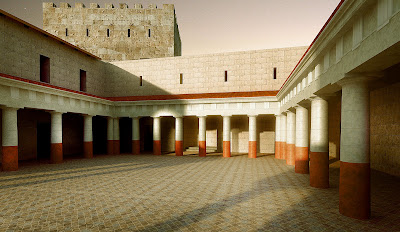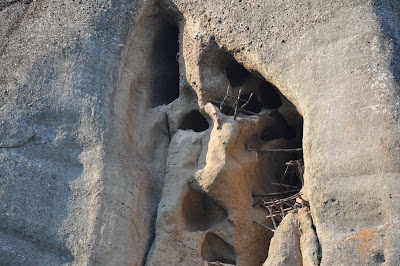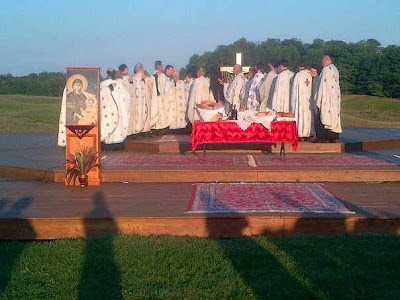The miracles referred to below have been selected from the Vatopaidi Monastery archives.
1. It’s difficult to have kids
Fr Theotimos comes from Congo. He studied theology in Greece. He wished to have kids so much but had a problem. He asked for the ribbon blessed on the Holy Belt. He describes the result.
12/3/1995
Methonis 23, Athens
The name of God-Man Christ must always be glorified and the name of the Panagia, the Mother of God must be honored.
We received the Holy Belt on March 1992. In May 1992 my wife became pregnant and we had a baby son weighing 2.900 gr. He was born with a caesarian section and we baptized him Marios, to honor the name of the Panagia. The doctors had previously verified that it would have been difficult for us to have children.
In April 1993 my wife was eight months pregnant and had a problem. She had to have another cesarean before the end of the gestation period. My wife wore the Holy Belt on her for two days before the operation. The baby, a girl, who was weighing only 1400 gr. was born having doubled her weight.
Fr. Theotimos and Evangelia Tsala.
2. The time we have longed for arrived
Athens
I would like to mention a miracle which took place to my wife, when she was wearing the Holy Belt of the Most Holy Mother of God, which a priest from your monastery had given us in August 1992, when I had visited the Holy Mountain.
But before I go into this, I would like to refer to another miracle which happened to both of us and made us completely change the way we live. Our life was definitely secular. We were knee deep into the sludge of lies and sin which our society provides in abundance. We had been walking a path which was supposedly leading us to happiness and joy but basically it was causing faction and finally eternal spiritual death.
The All Merciful God showed mercy on us. He gave us a present which we thought at first that it was unbearable. My wife had been diagnosed with compulsive neurosis. She was prescribed twelve pills a day to deal with depression, sadness and suicidal tendencies. She was having attacks and was crying all day. We visited many doctors, until we found our spiritual father, Fr E. Everything has changed since then. We turned towards the right path.
Even though my wife’s problem did not completely disappear, the psychiatrist, in cooperation with our spiritual father, advised us to have a child. However, because of my wife’s problem, it was difficult for her to become pregnant. We had been expecting help from above.
And now I am going to refer to the second miracle.
During our veneration of holy relics, the priest talked about the miracles that our Panagia performs on childless women with the blessed ribbons. All those who wore them and lived with repentance, become pregnant. Then I was fighting the thought to get one for us, but I was embarrassed. I was ready to leave, but something pushed me and I got one.
My wife had been wearing it all the time. We were praying and waiting. In November the same year, the time which we have yearned for has arrived. Now that I am writing this, we have a daughter who is 9.5 months old and is called Irene.
With respect,
Vasilis and Panayiota Aslanides.
3. The doctors had disappointed both of them
11/20/94
Livadia Larnaca, Cyprus
In 1993 I celebrated the Annunciation of the Mother of God at the Holy Mountain. Besides my personal need for prayer, I asked the fathers to pray for two spiritual sisters who had not had the joy of becoming mothers. The doctors had disappointed both of them.
At the end of the Paraklisis made for B. and G, I took the ribbons, after they were being blessed by the Holy Belt. When I returned to Cyprus, I had invited both of them to receive the blessings, which I had brought for them. B came and kissed the icons at the iconostasi, but did not take the ribbon that day, she took it later on. In the meantime, she became pregnant.
It took G more time to receive the blessing because she was staying far away. She had adopted a child. When we met, she took the ribbon and a few days later the doctor confirmed that she was pregnant.
Both of them visited me to announce their good news. All together we gave glory to the Panagia, the Mother of God.
Lenos Skitinis
4. I was married for seven years and didn’t have a child
6/2/1995
M.Bogdou 18, Xanthi
I had been married for seven years and didn’t have a child. My husband and I had tried many times to have a child and had visited various doctors in Athens and Thessaloniki. Finally at the end of our tether, you sent me a ribbon blessed by the Holy Belt of the Mother of God. I got pregnant and gave birth to a healthy baby boy on the 31st August 1993, on the feastday of the Holy Belt.
I certainly cannot express my gratitude enough and my adoration and awe for our Creator, who does great and wonderful things and continues to bless his worthless servant. I am pregnant again and the doctor told me that they are twins. Please write my son’s name, among the list of the miracles of our Panagia.
With a lot of respect and affection,
God’s servants,
Demetrios and Maria
5. Three healings
5/6/1995
Thessaloniki
We feel the need to express our gratitude for the great honor you have shown in bringing the Holy Belt to our home. It would be a great omission not to refer to the miracles we have seen being performed. We refer to some of them, fully realizing the magnitude of what we are about to write.
A military judge, who had a serious back problem and was walking bent, became well as soon as he left our home.
A fifteen year old child, who could never stand on his feet because of a congenital problem, began to walk as soon as he entered the house. It is important to say that his parents kissed the Holy Belt when you had already entered the car and were getting ready to leave. They told us about the miracle a few days later, because they had been afraid!
My husband’s colleague as soon as he put on some Holy Water on a funny spot which was suddenly growing and making him anxious, it disappeared immediately! This person did not come to our home to venerate the Holy Belt and the miracle had been performed just by the Holy Water.
May we have your blessing!
Paul and Fotini Papoulidou
6. We have been given two healthy boys
7/6/1995
Arch. Chrysostomos 1, Pafos, Cyprus
I am writing this letter as an indication of our gratitude to our Most Holy Mother of God and Ever-Virgin Maria, who has shown her magnanimity towards the sinful and humble servants of our Lord, once more.
She has performed a miracle on us, by giving us two healthy boys, after seven years of marriage. When I had visited your monastery in 1993, I prayed in front of her wonderworking icon and took the ribbon from her blessed Holy Belt. A year later the miracle happened. My wife became pregnant with twins.
I also extend my thanks to you because you have helped me find the true path of God which leads to eternal life. Please pray to our Lady that she grants health to the children, which she has given us so miraculously.
With the love of Christ,
Stelios and Eleni Kalli
7. Back pain stopped
9/20/1995
Themistokleous 31, Athens
During my visit to the Great and Holy Monastery of Vatopaidi on 8/25/1995, after the Vespers the priest brought out the body remains of saints and the Holy Belt of the Most Holy Mother of God for the visitors to worship. When this had finished, I asked the priest to read some prayers for me in the presence of the Holy Belt. He placed his stole and the Belt of the Panagia and started saying a prayer. While he was reading, I started feeling that I had been holding a great and very heavy load on my back, which was receding as the reading was progressing. When the prayer ended, I felt that the weight had disappeared. From that moment my back pain, which has given me so much trouble for so long, had disappeared.
I would like to express my infinite gratitude to our Panagia for the miracle she performed on me by completely curing my back pain.
With infinite thanks,
V. Papachristopoulos
8. The Holy Belt has miraculously given me 12 children
10/18/1995,
Patra
I have a 14-member family: myself, Fr Nicholas, my wife Anthi and twelve children. A crucial and great miracle of the Holy Belt is our having twelve kids.
When my wife was pregnant with our first child she had serious health problems. She was nearing her term but had no labor pains. The doctors had said that the baby was dead and that she had to abort it otherwise her life was in danger. However, she had placed her faith in God, was reciting Paraklesis and praying with the prayer rope. Our child in the end was born alive and healthy under the following miraculous circumstances.
A devout woman, when she heard about our problem, gave me a ribbon of the Holy Belt. She told me to tell my wife to wear it and everything would be all right. My wife did as she was told and after a while she gave birth to a graceful and blessed little girl.
My wife’s other pregnancies were also problematic, but with the grace of the Holy Belt, we have managed to have twelve kids, six boys and six girls.
And here is something else, which is also important. My wife had varicose veins on her legs and the doctors had advised her not to have another child since she was going to endanger her child’s life as well as her own during birth. Because she had placed her trust in the Mother of all people, she was never put in any danger.
With respect and love in Christ
Father Nicholas, Theologian and Teacher

































